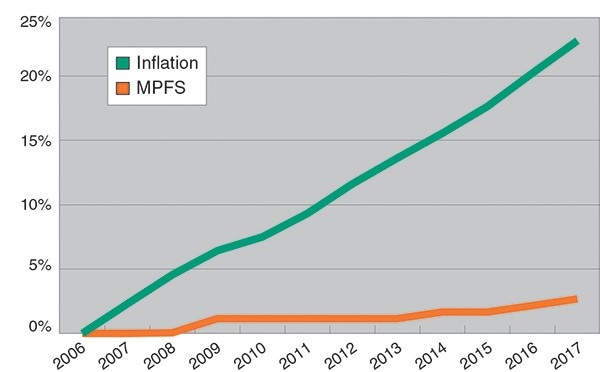Hospitals, Aviation and Business
 Friday, February 16, 2024 at 8:00AM
Friday, February 16, 2024 at 8:00AM Boeing’s recent troubles remind us that in many ways, healthcare is like aviation:
- They are both highly technical endeavors, guided by highly educated and trained personnel such as physicians and pilots.
- Even small mistakes can be devastating.
- Operating margins (operating income/revenue) are very low.
- Both are led by businessmen not trained in the industry.
- Some have put profit ahead of safety.
The cockpit of the typical airliner or the multitude of instruments in the typical intensive care unit demonstrates that aviation and medicine are both highly technical. Airline pilots have a minimum of 1,500 hours of flight time. This includes time spent obtaining a private pilot’s license, commercial license, instrument rating, multiengine rating, and airline transport pilot (ATP) certificate. Pilots often have additional in type ratings for turboprop or jet engines. Many have spent time as flight instructors and normally have at least 5 years of experience. A pilot must be over the age of 23 and be able to pass a 1st class medical exam. The military also trains pilots and brings them along faster, usually requiring some time commitment for the training they receive. In addition, they have recurring requirements to train in simulators to practice emergency procedures or when they begin flying new aircraft.
Physicians have four years of medical school after college. After medical school they become residents, a term from the past when the young physician resided in the hospitals. Residency lasts 3-5 years and is often followed by additional training called fellowship. For example, the typical cardiologist spends 3 years in an internal medicine resident, then an additional 3 years as a cardiology fellow. After fellowship, additional training may occur. For example, in cardiology this could be in interventional cardiology, nuclear cardiology, electrophysiology, etc. which are 1-2 years in length. In many cases additional time is spent doing research to become competitive for grants. Many have PhD’s and some have administrative or business degrees such as master of public health (MPH) or business (MBA). Like pilots, recertification is required. Nurses and physician’s assistants are also highly educated. Some have PhD’s and many have master’s degrees. Like physicians, administrative or business degrees are becoming increasingly common.
Small mistakes can be devastating. Overshooting or undershooting a runway leading to a crash can kill not only the pilot but passengers on board. Poor handling of an emergency such as an engine failure, a door plug dislodging in flight or poor programming of the complex flight computers, such as occurred with the Boeing 737 Max, can be lethal. Similarly, mistakes in care for a sick patient can be deadly. The popular literature is rife with reports of physicians or nurses overlooking a laboratory or x-ray abnormality, giving the wrong medication, falls, or the wrong surgery on the wrong patient.
Although the high education and need for care are well appreciated, what is not so well known is that profit margins are narrow for both aviation and medicine. Airlines are expected to have a 2.7% net profit margin in 2024 which is a slight improvement from the 2.6% in 2023 (1). Boeing’s net profit margin as of September 30, 2023 was -2.86%. (2). Hospitals began 2023 with a median operating margin of -0.9% and currently have a margin of -10.6% to 11.1% (3). For the three months ending Sept 30, the Mayo Clinic (Rochester, MN) had a relatively healthy 6.7% profit margin. In contrast, Banner Health was only 1.5%. Hospitals and health systems are estimated to finally break even after several years of losses secondary to the COVID-19 pandemic and higher than expected contract labor costs. The recent median margin data show that essentially half of hospitals and health systems are still operating at a financial loss, with many more just barely covering their costs (3). This means little to no discretionary money. Hospital executives who receive high compensation packages can consume much of this discretionary money. Many would argue that it could be better spent on patient care.
Both aviation and hospitals are usually led by businessmen. This was not always so. Early airlines and hospitals were usually led by pilots and doctors. Only in the past 50 years have businessmen become involved. The rationale has nearly always been financial. Early aviators cared a great deal about demonstrating that aviation was safe. For example, Boeing Aircraft, founded in 1916 by William Boeing, was considered first and foremost an engineering firm where production of reliable aircraft was most important (4). The emphasis on quality and safety spawned the quote, “If it isn’t Boeing, we aren’t going”. In 1997 Boeing merged with its longtime rival McDonnell Douglas. The new CEO of the merged companies from McDonnell Douglas, Harry Stonecipher, brought a different attitude to the merged companies.

Figure 1. Harry Stonecipher. CEO of Boeing 2001-2, 2003-5.
Stonecipher said, “When people say I changed the culture of Boeing, that was the intent, so that it’s run like a business rather than a great engineering firm. It is a great engineering firm but people invest in a company because they want to make money” (5). The company became fixated on stock market value and lost sight of the core value of manufacturing reliable, safe airplanes. Boeing is now reaping the decline in quality that was sown by Stonecipher years ago. The Federal Aviation Administration (FAA) which is supposed to oversee airplane manufactures has also apparently become slack, allowing Boeing to have major declines in quality (6).
In hospitals we have seen a similar progression. Doctors or nurses were replaced as hospital heads in the later part of the twentieth century by businessmen who often did not understand, and in some instances did not care to understand, the core value of quality patient care. Recently, private equity firms have been acquiring hospitals or portions of hospitals such as emergency rooms or radiology practices. Data on the quality of care has been scant but there have been a multitude of complaints from doctors and nurses. Now, a recent systematic review that included 55 studies from 8 countries concluded that not only has private equity ownership increased over time across many health care sectors, but it has also been linked with higher costs to patients or payers (7). Although results for the 27 studies that looked at health care quality were mixed, the researchers found evidence that private equity ownership was tied to worse quality in 21 (7). This suggests a poorer quality of care. The lack of oversight by a variety of healthcare organizations such as the Joint Commission, Centers for Medicare and Medicaid Services (CMS), state departments of health, etc. may be following the FAA example in becoming lax at their jobs.
Hospitals and aviation companies do have one major difference. Hospitals are generally not-for-profit entities that should operate for the public good. Profit is secondary which does not mean that losses can be long tolerated. Aviation companies are for-profit entities where revenue is primary. However, as demonstrated by Boeing, quality is still very important. As more hospitals are acquired by private equity companies, many remain concerned that quality will suffer for the sake of profit. Perhaps in 20 years we will be shaking our heads and lamenting about the decline in the quality of US healthcare the way many are viewing Boeing today.
Richard A. Robbins MD
Editor, SWJPCCS
References
- https://www.iata.org/en/pressroom/2023-releases/2023-12-06-01/#:~:text=Airline%20industry%20net%20profits%20are,2.6%25%20net%20profit%20margin)
- Boeing Profit Margin 2010-2023. Macrotrends. Available at: https://www.macrotrends.net/stocks/charts/BA/boeing/profit-margins#:~:text=Current%20and%20historical%20gross%20margin,%2C%202023%20is%20%2D2.86%25 (accessed 2/9/24).
- Condon A, Ashley M. From -10.6% to 11.1%: 34 systems ranked by operating margins. Becker’s Hospital Review. December 29, 2023. Available at: https://www.beckershospitalreview.com/finance/from-10-6-to-11-1-34-systems-ranked-by-operating-margins.html (accessed 2/9/24).
- Boeing. Wikipedia. Available at: https://en.wikipedia.org/wiki/Boeing (accessed 2/9/24).
- Surowiecki J. What’s Gone Wrong at Boeing. The Atlantic. January 15, 2024. Available at: https://www.theatlantic.com/ideas/archive/2024/01/boeing-737-max-corporate-culture/677120/ (accessed 2/9/24).
- Rose J. The FAA is tightening oversight of Boeing and will audit production of the 737 Max 9. January 12, 2024. NPR. Available at: https://www.npr.org/2024/01/12/1224444590/boeing-faa-737-max-9-alaska-airlines-door-plug (accessed 2/9/24).
- Harris E. Private Equity Ownership in Health Care Linked to Higher Costs, Worse Quality. JAMA. 2023 Aug 22;330(8):685-686. [CrossRef] [PubMed]

